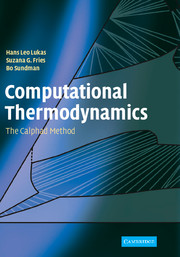
-
Select format
-
- Publisher:
- Cambridge University Press
- Publication date:
- February 2011
- July 2007
- ISBN:
- 9780511804137
- 9780521868112
- Dimensions:
- (247 x 174 mm)
- Weight & Pages:
- 0.8kg, 324 Pages
- Dimensions:
- Weight & Pages:
You may already have access via personal or institutional login
Book description
Phase diagrams are used in materials research and engineering to understand the interrelationship between composition, microstructure and process conditions. In complex systems, computational methods such as CALPHAD are employed to model thermodynamic properties for each phase and simulate multicomponent phase behavior. Written by recognized experts in the field, this is an introductory guide to the CALPHAD method, providing a theoretical and practical approach. Building on core thermodynamic principles, this 2007 book applies crystallography, first principles methods and experimental data to computational phase behavior modeling using the CALPHAD method. With a chapter dedicated to creating thermodynamic databases, the reader will be confident in assessing, optimizing and validating complex thermodynamic systems alongside database construction and manipulation. Several case studies put the methods into a practical context, making this suitable for use on advanced materials design and engineering courses and an invaluable reference to those using thermodynamic data in their research or simulations.
Reviews
"Lukas (U. Stuttgart emeritus) and co-authors Sundman (Paul Sabatier U.) and independent scientist Fries provide the first introductory guide to this method of computation that combines data from thermodynamics, phase diagrams, and atomistic properties such as magnetism into a unified and consistent model. They introduce the science and art of computational thermodynamics and the past and present of the Calphad technique, the scientific basis of the technique (including thermodynamics, crystallography, equilibrium calculations and optimization methods), first principles and thermodynamic properties, experimental data needed for optimization, models for the Gibbs energy element, assessment methodology, optimization tools, and thermodynamic databases. They also offer a series of case studies, including a complete assessment of the Cu-Mg system and a complete binary system (Ca-Ng) and provide a list of websites along with comprehensive references."--Book News
Contents
Metrics
Altmetric attention score
Full text views
Full text views help Loading metrics...
Loading metrics...
* Views captured on Cambridge Core between #date#. This data will be updated every 24 hours.
Usage data cannot currently be displayed.
Accessibility standard: Unknown
Why this information is here
This section outlines the accessibility features of this content - including support for screen readers, full keyboard navigation and high-contrast display options. This may not be relevant for you.
Accessibility Information
Accessibility compliance for the PDF of this book is currently unknown and may be updated in the future.


